- Blog
The Ultimate Guide to PC Case Types and Popular Brands (for Beginners and Modders)

Table of Contents
ToggleChoosing a PC case is one of the most consequential decisions you’ll make when building or refreshing a desktop. The case doesn’t just hold your parts; it shapes airflow, thermals, noise, upgradability, and the overall look and feel of the machine for years. For newcomers it can be overwhelming, and for modders it’s where creativity truly lives—panels, loops, cables, and light all converge here. This guide walks you through every major category of PC case on the market right now—what each type is, who it’s for, typical price ranges, and brand + model examples (both current favorites and formative classics). The goal is to help beginners and enthusiasts make confident, informed choices.
How to Read This Guide
For each case category you’ll find:
-
Definition & Traits – What it is and how it differs from other types.
-
Use Cases & Who It’s For – Ideal users and scenarios (gaming, workstation, living-room, compact setups, showcase builds, etc.).
-
Budget Guidance – Rough price bands (entry / mid-range / high-end) and what you typically gain by stepping up.
-
Popular Brands & Models – Representative cases you can research and compare; classics are included when historically relevant.
Note on availability: specific models come and go; treat model lists as starting points for research. Most brands refresh lines every 1–3 years.
1) ATX Mid-Tower
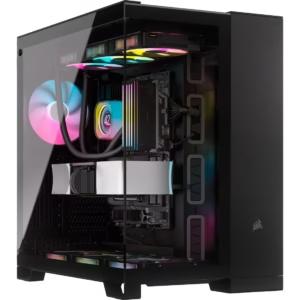
Definition & Traits
The ATX mid-tower is the most common PC case format. Heights typically fall in the ~16–24 in (40–60 cm) range, supporting ATX motherboards and usually micro-ATX and mini-ITX as well. The appeal is balance: ample space for long GPUs, tall air coolers or 240/280/360 mm radiators, several 2.5″/3.5″ drives, and clean cable management—without the footprint of a full tower.
Most modern mid-towers emphasize either high airflow (mesh fronts, many fan mounts) or quiet operation (sound-damped panels, airflow channels). Side panels are often tempered glass.
Use Cases & Who It’s For
-
Beginners who want a forgiving build experience and straightforward cable routing.
-
Gamers running a single powerful GPU, possibly AIO water cooling, and multiple fans for optimal thermals.
-
General-purpose builds—from family PCs to light production work—thanks to broad compatibility and value.
Budget Guidance
-
Entry (≈ US$60–120): functional steel chassis, tempered glass on many models, 2–4 preinstalled fans, basic cable covers.
-
Mid-range (≈ US$120–200): better steel thickness, high-airflow mesh fronts, USB-C front I/O, extensive radiator support, more refined cable channels and drive caddies.
-
High-end (US$200+): premium fit/finish, panoramic glass, modular interiors, vertical GPU options/brackets, PWM/ARGB hubs, hot-swap drive cages, hinged panels.
Popular Brands & Models
-
Current mainstream:
-
Fractal Design Pop Air / Meshify 2 Compact – clean Scandinavian look, excellent airflow options, friendly interiors.
-
NZXT H5 Flow – modern, minimal design with a perforated front; well-tuned airflow and simple building experience.
-
Corsair 4000D Airflow / 5000D Airflow – mesh-forward, great cable channels, tasteful lighting options.
-
Lian Li Lancool 216 / 205 Mesh – value-oriented airflow with big front fans and smart layout.
-
Phanteks Eclipse G360A / P400A – high-airflow classics with a reputation for thermal performance.
-
-
Classics:
-
Fractal Design Define R5/R6 – the gold standard for quiet mid-towers (damped panels, modular drives).
-
Cooler Master HAF 912 – an early icon of big-fan, mesh-front airflow.
-
2) ATX Full-Tower
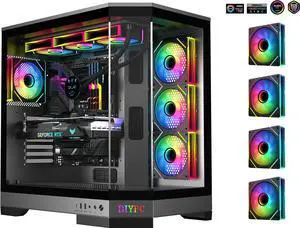
Definition & Traits
Full-tower cases are the big SUVs of the PC world. You’ll typically see E-ATX motherboard support, towering heights (24 in / 60+ cm), extensive radiator space (multiple 360/420 mm), vertical GPU options, and room for several HDDs/SSDs. Many full towers feature dual-chamber structures, removable motherboard trays, and front-panel USB-C plus hot-swap drive bays.
Use Cases & Who It’s For
-
High-end gaming rigs with flagship GPUs, custom loops, and lots of RGB/ARGB.
-
Workstations for 3D, VFX, CAD, video—where you need many drives, capture cards, or accelerators.
-
Modding canvases—massive interior volume lets creativity run wild.
Budget Guidance
-
Mid-range (≈ US$150–250): big interiors, solid airflow, enough radiator support for dual AIOs.
-
High-end (US$250–500+): thicker steel or aluminum, panoramic or wraparound glass, tool-less hinged panels, extensive modularity, multi-radiator custom loop support.
Popular Brands & Models
-
Current mainstream:
-
Phanteks Enthoo 719 / 700 series – modular, water-cooling oriented, supports dual systems in some configs.
-
Thermaltake Core P8 TG / View 91 TG – massive glass and open-style layouts; Core P8 can function like a showcase tower.
-
Corsair 7000D Airflow – huge radiator support, elegant cable routing spine, premium feel.
-
-
Classics:
-
Cooler Master HAF X – the poster child of old-school high-airflow.
-
Cooler Master Cosmos series – a design icon with premium materials and carry bars.
-
3) micro-ATX Tower (mATX)
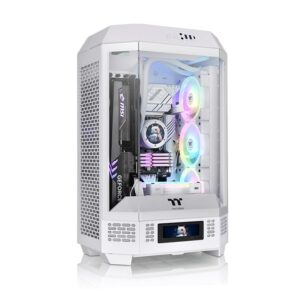
Definition & Traits
micro-ATX towers are a size down from mid-towers, designed around mATX boards (usually 4 expansion slots). They preserve a “tower” build style but reduce height and depth, trimming drive capacity and sometimes radiator clearance.
Use Cases & Who It’s For
-
Budget-friendly builds where you still want a discrete GPU and decent airflow.
-
Home/office PCs or student builds that aim to save space without entering ITX territory.
-
First-time builders who like a compact tower that’s easier to place on or under a desk.
Budget Guidance
-
Entry (≈ US$50–90): simple steel and acrylic/tempered glass, a couple of fans.
-
Mid-range (≈ US$90–150): better mesh fronts, nicer cable pathways, Type-C front I/O, room for 240 mm AIOs.
-
High-end (US$150+): rarer in mATX, but you’ll find premium materials and boutique designs.
Popular Brands & Models
-
Current mainstream:
-
Cooler Master MasterBox Q300L – small footprint, magnetic dust filters, rotating I/O, great value.
-
Fractal Design Pop Mini Air – airflow-first, with clever storage options and tasteful RGB.
-
-
Classics:
-
Corsair Carbide Air 240 – dual-chamber cube mATX; compact yet radiator-friendly.
-
SilverStone TJ08-E – legendary mATX tower with a front 180 mm fan that punched far above its size.
-
4) Mini-ITX (ITX) Towers & “SFF” (Small Form Factor)
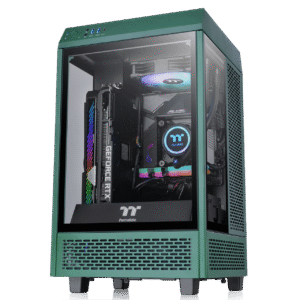
Definition & Traits
Mini-ITX (170 × 170 mm motherboard) is the heart of SFF culture. Many ITX cases are 10–20 liters, some under 10 L. Layouts are wildly creative: sandwich styles with a PCIe riser for a vertical GPU, shoebox layouts, console-like towers, and chimney-style airflow. Constraints are real: SFX/SFX-L PSUs are common, GPU length/height and CPU cooler clearance must be checked obsessively.
Use Cases & Who It’s For
-
Space-conscious builders and LAN party travelers.
-
Aesthetic minimalists who want console-sized power.
-
Modders who enjoy the puzzle: airflow tuning, custom cables, and clever component choices.
Budget Guidance
-
Entry (≈ US$60–120): compact steel/plastic shells; limited radiator options; fine for modest specs.
-
Mid-range (≈ US$120–250): aluminum panels, riser brackets, mesh or glass side options, 240/280 mm AIO support in some designs.
-
High-end / boutique (US$250–500+): premium aluminum, incredibly tight tolerances, innovative layouts, limited runs.
Popular Brands & Models
-
Current mainstream:
-
Cooler Master NR200 / NR200P – the people’s ITX case: generous GPU and cooler clearance, 240/280 mm radiator support, swappable glass/mesh panels, strong community ecosystem.
-
Lian Li Q58 – dual-hinged panels (mesh + glass), flexible PSU support (SFX or ATX), clever modularity in ~14.5 L.
-
HYTE Revolt 3 – vertical console-like footprint with integrated handle and hooks; easy travel case.
-
-
All-in-one concept:
-
NZXT H1 (v2) – includes SFX PSU, 140 mm AIO, and riser; very fast to build, sleek living-room friendly tower.
-
-
Classics / boutique legends:
-
BitFenix Prodigy – the case that popularized “big-GPU in small box.”
-
NCASE M1 – a community-designed aluminum marvel; tiny volume yet shockingly capable.
-
DAN Case A4-SFX – iconic 7-ish liter sandwich case that pushed SFF minimalism forward.
-
SFF Tip: plan airflow and cable lengths early. Short custom cables (or a cable kit) can transform thermals, acoustics, and build cleanliness.
5) SFF as a Broader Category
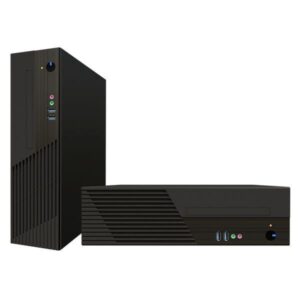
While many SFF cases are ITX, the term SFF also includes compact mATX/ATX designs that achieve small volume through inventive layouts (dual chambers, rotated boards, vertical GPUs). Expect strict dimension checks for GPUs, radiators, and coolers, and sometimes unusual drive mounting.
Who benefits: commuters, small apartments, minimalist desks, portable e-sports rigs, and modders who want to showcase packing density.
Price ranges: generally mid to high given the engineering required; premium aluminum and custom hardware drive costs up.
Current notables:
-
SSUPD Meshroom / Meshlicious (SSUPD is a Lian Li spin-off) – mesh-heavy, modular GPU/PSU configurations.
-
Fractal Terra – premium aluminum/wood aesthetic with clever interior rails.
-
Sliger, FormD, Louqe – boutique SFF brands with cult followings (availability varies).
6) Open-Frame / Open-Air
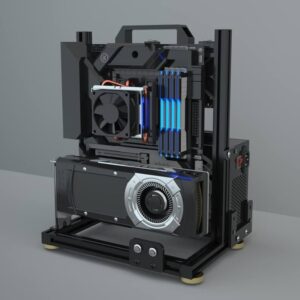
Definition & Traits
Open-frame cases expose the system with little or no enclosure—think test benches and artful metal frames. With no conventional panels, airflow is unrestricted. Cable management and presentation become part of the build’s artistry.
Use Cases & Who It’s For
-
Benchmarkers, reviewers, and overclockers who frequently swap parts.
-
Showpiece modders who want 360-degree visibility—RGB, rigid tubing, and custom metalwork all on display.
-
Expo or retail displays where hardware is the spectacle.
Pros & Cons
-
Pros: unparalleled access; minimal thermal restriction; easiest loop routing; striking visuals.
-
Cons: dust exposure, zero noise isolation, and less physical protection. Public spaces often require a clear acrylic shroud or enclosure for safety.
Budget Guidance
-
Entry (≈ US$50–150): acrylic or steel test benches with simple trays and posts.
-
Mid/high (US$150–400+): stylized frames, tempered glass wings, multiple radiator brackets, wall-mount options.
-
Premium art pieces (US$400–1000+): CNC aluminum tubes/plates, limited-run designs.
Popular Brands & Models
-
Current mainstream:
-
Thermaltake Core P3 / P5 / P8 – semi-open, massive glass, wall-mountable; great for custom loops and cable art.
-
Cooler Master MasterFrame 700 – converts between showcase and test-bench modes; VESA mount support.
-
-
Classics:
-
InWin D-Frame – welded tubular exoskeleton with glass; a collectible design icon.
-
Antec Torque – aggressive, layered aluminum sculpture of a case.
-
7) HTPC (Home Theater PC) Cases
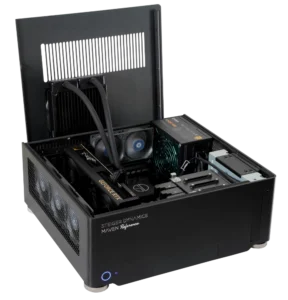
Definition & Traits
HTPC cases are purpose-built for the living room: low-profile, horizontal layouts that aesthetically match AV receivers. Focus areas are silence, low height, and clean fronts (brushed aluminum, sometimes VFD/LCD windows or IR receivers).
Use Cases & Who It’s For
-
Media enthusiasts who want a PC in the TV console for local media, streaming, emulation, or light gaming.
-
Multi-room audio/video setups where the PC doubles as a server and playback device.
Constraints
Height limits CPU coolers and full-height cards; short GPUs or riser-based horizontal GPUs are typical. Airflow is deliberate rather than brute force.
Budget Guidance
-
Entry (≈ US$70–150): basic steel shells, limited fans, acceptable for low-watt builds.
-
Mid (≈ US$150–300): aluminum fronts, better acoustics, IR windows, additional fans/filters.
-
High (US$300+): premium aluminum, display windows, extensive silencing.
Popular Brands & Models
-
Current mainstream:
-
SilverStone Grandia (e.g., GD09/GD11) – ATX-capable, logically vented, designed to slide into AV cabinets.
-
-
Classics / niche premiums:
-
Origen AE S-series – luxury AV-styled aluminum with displays and IR; fewer are made today but they set the standard.
-
Antec Fusion Remote – formative quiet HTPC case with VFD and remote.
-
Lian Li PC-C series – elegant aluminum horizontals that blend with audio gear.
-
8) Desktop / Horizontal (Non-HTPC)
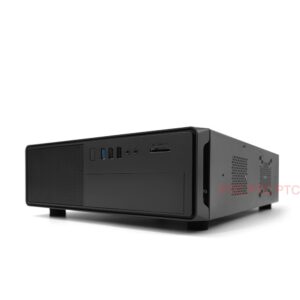
Definition & Traits
“Desktop” or horizontal cases are flat, monitor-era throwbacks or business-class boxes. Some share DNA with HTPC but skew toward office or specialty uses (instrumentation, kiosks, legacy equipment integration).
Use Cases & Who It’s For
-
Nostalgia builds, retro-themed spaces, or desks where stacking equipment on top of the case is helpful.
-
Specialty installs that prefer a stable, low profile.
Budget Guidance
Mostly entry to mid; high-end horizontals have largely shifted to the HTPC niche.
Popular Brands & Models
-
Current mainstream:
-
SilverStone Milo ML04/ML05 – slim horizontals suitable for office or media roles.
-
-
Classic:
-
InWin BK-series – office-friendly horizontals popular in SFF business deployments.
-
9) Wall-Mountable Cases
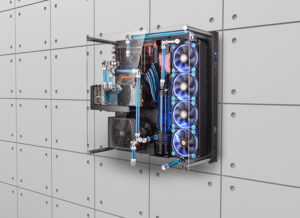
Definition & Traits
Wall-mount cases bolt to the wall like a TV. Most are open-frame or semi-open with large tempered glass fronts. Cable routing is often designed to run behind the board for a clean wall presentation.
Use Cases & Who It’s For
-
Showpiece builds in gaming rooms, cafés, studios, and esports venues.
-
Space savers who prefer floor and desk cleared.
Budget Guidance
-
Mid (≈ US$150–300): open frames with basic brackets.
-
High (US$300–600+): heavy glass panels, premium frames, and dedicated wall hardware.
Popular Brands & Models
-
Current mainstream:
-
Thermaltake Core P5/P8 – the de facto wall-mount showcase standard.
-
Cooler Master MasterFrame 700 – VESA-compatible plate for robust mounting.
-
-
Classics:
-
Lian Li PC-O5/O7 – ultra-sleek thin wallable cases with risers for horizontal GPUs.
-
Wall mounting requires careful stud anchoring and clearance planning for cables, PSU, and radiators. Treat it like hanging a heavy TV.
10) Modular / Reconfigurable Cases
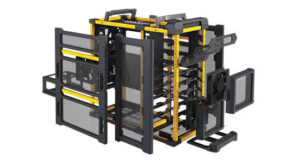
Definition & Traits
Modular cases embrace “Freedom to Mod”—interiors built from swappable modules (motherboard tray, PSU/drive chambers, fan/radiator panels) that can be repositioned, inverted, stacked, or expanded. The case becomes a platform rather than a fixed layout.
Use Cases & Who It’s For
-
Modders and tinkerers who change hardware often or want to experiment with custom loops and inverted layouts.
-
Show builds that require unique component placements, dual systems, or expansion beyond a single shell.
Budget Guidance
-
Mid (≈ US$150–250): semi-modular towers with replacable panels/brackets.
-
High (US$250–600+): true modular frameworks, stackable cubes, or kits you assemble yourself.
Popular Brands & Models
-
Current mainstream:
-
InWin ModFree – a module-block framework; trays can invert or stack, enabling unconventional airflow/water-cooling layouts.
-
Cooler Master MasterCase (FreeForm) – swappable panels, cages, and accessories to re-shape the chassis.
-
-
Classics / special concepts:
-
Thermaltake Core X9 – stackable cube that can scale into a behemoth (dual systems or massive loop separation).
-
Antec LanBoy Air – early experiment in fully reconfigurable mesh and bracket ecosystems.
-
Buying by Goal: A Quick Decision Map
“I’m a first-time builder and want something safe and cool.”
→ ATX Mid-Tower (mesh front) from Fractal, Corsair, Phanteks, NZXT, or Lian Li. Budget US$80–150 for the case and US$20–60 for extra fans if needed.
“I’m chasing silence.”
→ Sound-damped mid-tower (Fractal Define series, be quiet! Silent Base). Use larger 140/180 mm fans at low RPM and consider a quiet AIO or tower cooler.
“I’m building a workstation with many drives and radiators.”
→ Full-tower (Corsair 7000D, Phanteks Enthoo 719, Fractal Define 7 XL). Expect US$200–400 for the shell and room for multiple 360/420 rads.
“I crave small and portable but powerful.”
→ ITX / SFF (NR200/NR200P, Lian Li Q58, SSUPD Meshroom). Plan for SFX PSU and verify GPU length/height; SFF will reward diligent planning.
“I want to put the PC on a wall or turn it into art.”
→ Open-frame or wall-mount (Thermaltake Core P series, MasterFrame 700, InWin open frames). Factor in clear acrylic guards if accessible to others.
“I mod everything and switch hardware constantly.”
→ Modular platforms (InWin ModFree, TT Core X series, MasterCase FreeForm). Buy extra brackets early; the ecosystem is the value.
Airflow, Radiators, and Noise: Practical Considerations
Airflow styles
-
High-airflow mesh fronts are the easiest route to good thermals. If your GPU is a 2.5–3-slot beast and you game at high load, prioritize mesh.
-
Quiet/closed fronts rely on side/top/bottom intakes; you’ll want better fans, tuned fan curves, and dust maintenance.
Radiator planning
-
240/280 mm AIOs are comfortable in most mid-towers (top or front). 360 mm is common now but verify RAM and VRM heatsink clearance up top.
-
In SFF, many cases cap at 240 mm or use 120/140 mm slim radiators. Always check thickness + fan stack heights.
Fan choices
-
High-airflow fans (wider blade spacing) for open intakes/exhausts.
-
High static pressure fans (tighter blades) for radiators, dense dust filters, and restrictive front panels.
-
140 mm fans typically move more air at lower noise than 120 mm at a given loudness.
Noise
-
Bigger, slower fans = quieter.
-
Rubber isolation and sturdy panels reduce vibration hum.
-
Glass looks great but can reflect noise more than well-damped steel.
Materials, Build Quality, and Maintenance
Materials
-
SECC steel is standard; thickness impacts rigidity and perceived quality.
-
Aluminum brings lightness and a premium look (often higher price).
-
Tempered glass provides clarity and scratch resistance; acrylic is lighter but more scratch-prone.
Build quality
-
Look for properly rolled panel edges, stout thumbscrews, hinged doors, and latching mechanisms instead of bare screws.
-
Modern cases should have cable channels, Velcro straps, and ample tie-points.
Filters & cleaning
-
Removable magnetic filters (front/top/bottom) save time.
-
Positive pressure (more intake than exhaust) can reduce dust but requires decent filtration on intakes and routine vacuuming.
Brand Landscape Overview (Cheat Sheet)
-
Fractal Design – clean, quiet, airflow-savvy; excellent cable management.
-
Lian Li / SSUPD – aluminum artisanship, elegant glass, strong airflow; SFF innovators (Q58, Meshlicious).
-
Corsair – polished cable channels, iCUE ecosystem, airflow variants across 3000/4000/5000/7000 series.
-
NZXT – minimalist styling, builder-friendly interiors; H-series is a safe bet.
-
Phanteks – modular thinking, strong radiator support, value airflow (Eclipse, Enthoo lines).
-
Cooler Master – breadth from budget to halo; HAF (airflow), MasterFrame (open), NR200 (SFF champ).
-
Thermaltake – showpiece glass and open-frame (Core P), stackable cubes (Core X), RGB ecosystems.
-
InWin – bold concept designs (D-Frame, ModFree), DIY kit cases (e.g., Airforce).
-
HYTE – fresh aesthetics and playful function (Revolt 3, Y-series).
-
SilverStone – HTPC masters (Grandia), classic SFF (Sugo), airflow experiments.
-
be quiet! – quiet-first tower cases with refined damping and bundled silent fans.
Pricing Reality: Where the Money Goes
-
Under US$100: you can get a capable mid-tower with mesh front and glass side; fans may need upgrading.
-
US$100–200: sweet spot—great airflow, tempered glass, cable luxuries, radiator support, USB-C.
-
US$200–400: premium materials, panoramic glass, hinged panels, PWM/ARGB hubs, high radiator counts.
-
US$400+: halo cases (giant full towers, open-frame art, boutique SFF aluminum).
When budgeting, remember to reserve funds for quality fans (and potentially a vertical GPU bracket or riser if you want that look). Cooling and acoustics are as much about fans and setup as the case shell itself.
Final Recommendations
Beginner on a reasonable budget
-
Case type: ATX mid-tower, mesh front.
-
Why: easiest to build, least compatibility headaches, future-proof for upgrades.
-
Try: Fractal Pop Air, Corsair 4000D Airflow, NZXT H5 Flow, Lian Li Lancool 216, Phanteks P400A/G360A.
Modder / Loop enthusiast
-
Case type: large mid-tower or full-tower; open-frame/wall-mount if showcasing.
-
Why: radiator and pump/res clearance, showmanship, ease of maintenance.
-
Try: Phanteks Enthoo 719, Corsair 7000D, Thermaltake Core P3/P5/P8, Cooler Master MasterFrame 700.
SFF zealot
-
Case type: Mini-ITX / SFF (10–20 L).
-
Why: small footprint with big performance, challenge and reward of tight builds.
-
Try: Cooler Master NR200P, Lian Li Q58, SSUPD Meshlicious/Meshroom; boutique: NCASE M1, DAN A4-SFX.
Living-room media center
-
Case type: HTPC horizontal.
-
Why: AV-rack fit, quiet, tasteful front panel.
-
Try: SilverStone Grandia GD09/GD11; consider low-profile coolers and short GPUs.
Workstation & storage monster
-
Case type: full-tower with many drive bays and multi-rad support.
-
Why: sustained thermals, cable discipline, expansion headroom.
-
Try: Fractal Define 7 XL, Corsair 7000D, Phanteks Enthoo 719.





